Gerver R.K., Sgroi R.J. Financial Algebra
Подождите немного. Документ загружается.

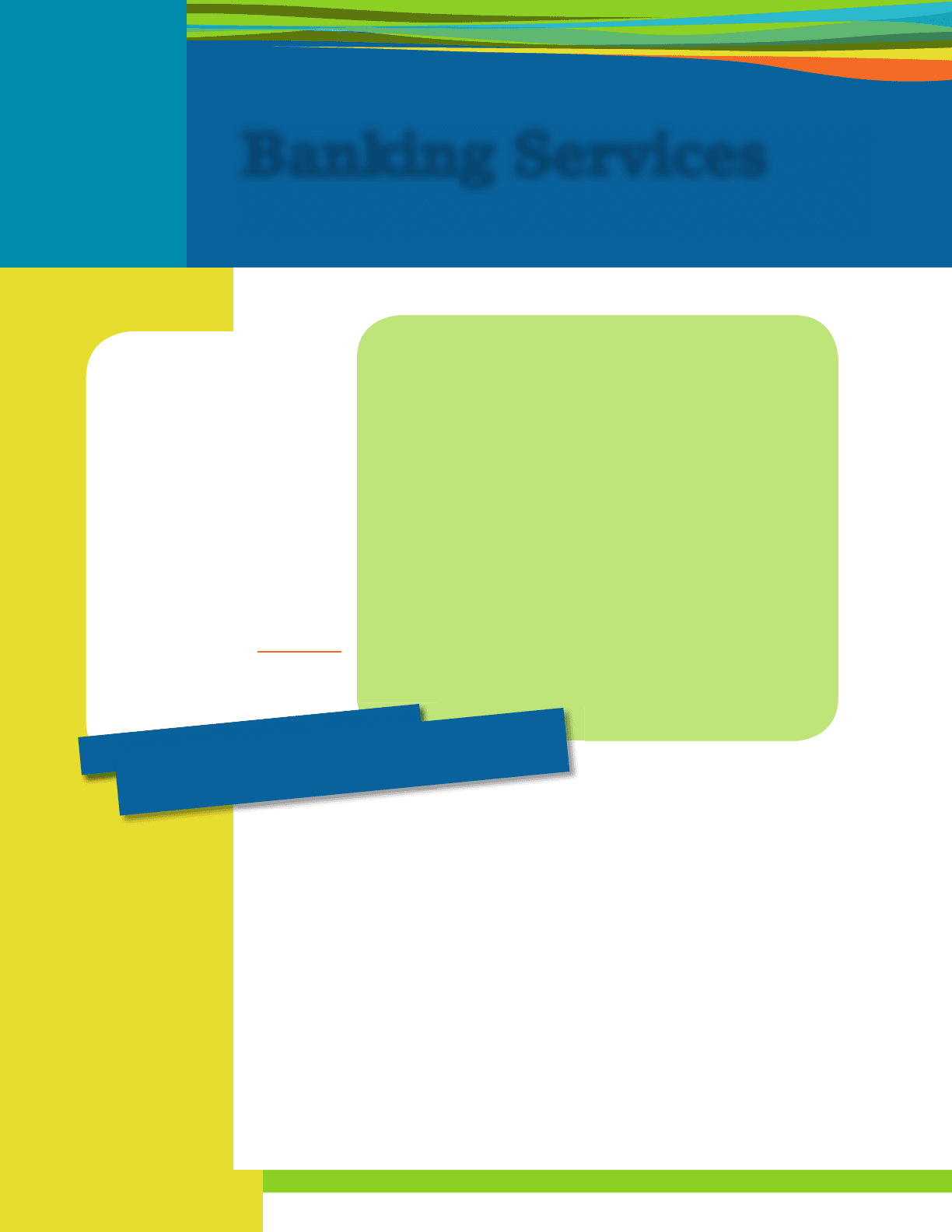
Chapters 1 and 2 introduced you to the
business world. In that world, people take risks and make
investments in businesses with the hope of making money. Where
do people keep the money they earn? They keep it in checking
accounts and savings accounts in banks. The money in their check-
ing accounts is used to pay bills, and the money in their savings
accounts is actually another form of investment. In Chapter 3, this
less risky form of investment is examined. Although savings accounts
may already be familiar, Chapter 3 answers questions about unknown
factors of savings accounts. How safe is your money in a bank? Where
do banks get the money they pay you in interest? Can you get rich
from the interest? What requirements are involved in opening an
account? Together, Chapters 1, 2, and 3 give an inside look at the
different degrees of risk and reward inherent in investing money in
different ways.
CHAPTER
The entire essence
of America is
the hope to fi rst
make money—
then make money
with money—
then make lots of
money with lots of
money.
Paul Erdman, Business and
Financial Author
Banking ServicesBanking Services
3-1 Checking Accounts
3-2 Reconcile a Bank Statement
3-3 Savings Accounts
3-4 Explore Compound Interest
3-5 Compound Interest Formula
3-6 Continuous Compounding
3-7 Future Value of Investments
3-8 Present Value of Investments
3
Cha
p
ters 1 an
d
business world. In that world, p
What does
Paul Erdman mean in this quotation?
49657_03_ch03_p114-171.indd 11449657_03_ch03_p114-171.indd 114 12/23/09 6:25:24 PM12/23/09 6:25:24 PM
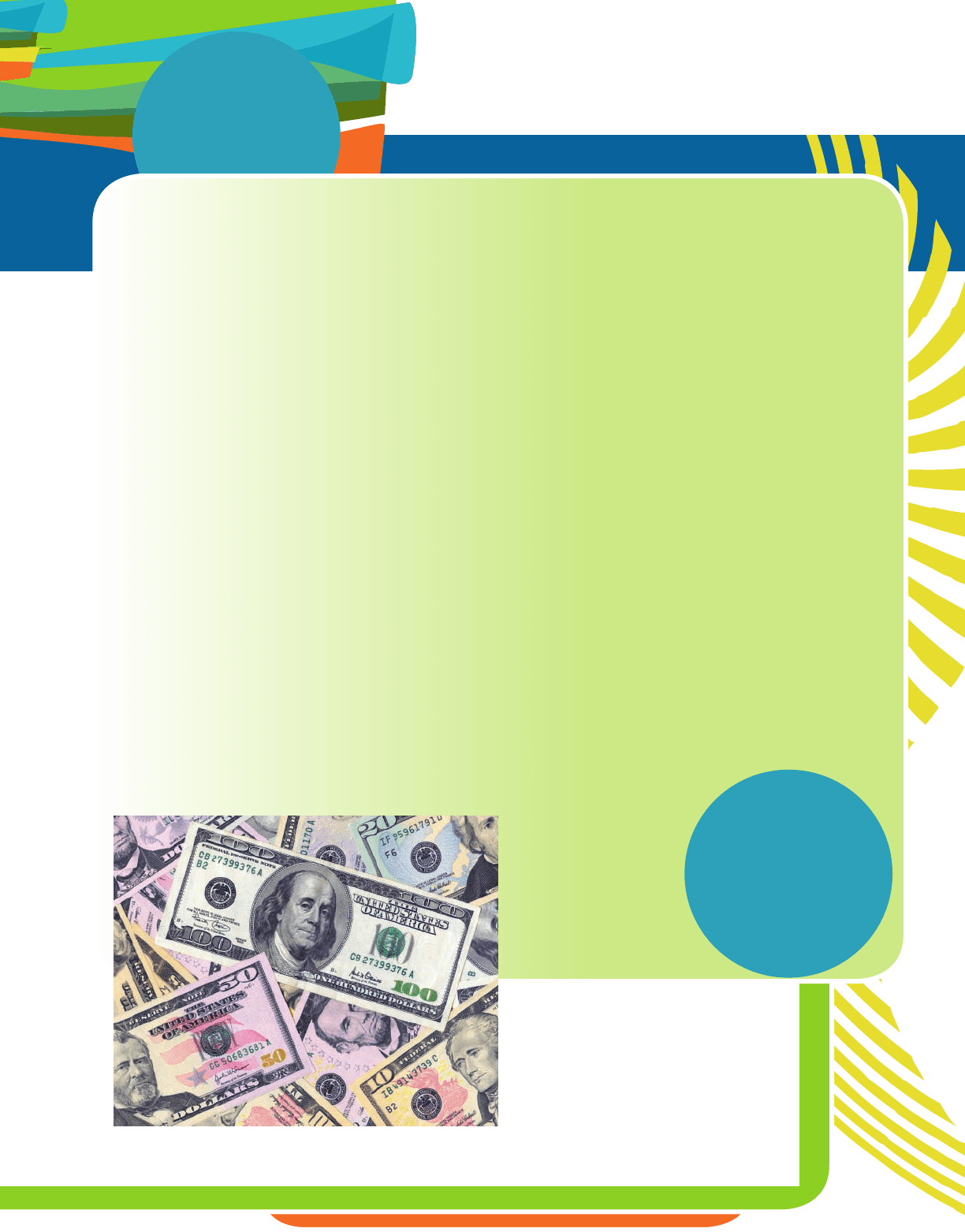
115
©GUENTERMANAUS, 2009
© POPRUGIN ALEKSEY, 2009/USED UNDER
LICENSE FROM SHUTTERSTOCK.COM
Really!
Really?
Most people are familiar with the United States Secret
Service as the group that guards the President. Its of cers
are frequently seen on television surrounding the President
as he tends to the affairs of the country.
What most people do not realize is that the Secret
Service, established in 1865, was created to help the United
States government combat the widespread counterfeiting of
U.S. currency at the time. Counterfeiting, one of the oldest
crimes in history, had become a national problem. It is esti-
mated that approximately
1
__
3
to
1
__
2
of the nation’s currency in
circulation at that time was counterfeit.
The problem, although not as severe, still exists today.
Modern printing and scanning equipment makes counter-
feiting easier, and the government has instituted changes
in currency to make it harder to counterfeit. Although most
citizens have no intentions of counterfeiting U.S. currency,
Americans have a responsibility to learn about counterfeit-
ing, because they may receive a counterfeit bill one day.
If a counterfeit bill is received, try to recall where it was
acquired. Contact the nearest Secret Service of ce. The bill
will be taken and no compensation will be returned to you.
If a counterfeit bill is deposited in a bank account, you will
lose the bill and the credit for the value of the deposit. Go
to the Federal Reserve Bank website and read tips for spot-
ting counterfeit currency. The penalty for trying to pass a
counterfeit bill is a ne or imprisonment.
49657_03_ch03_p114-171.indd 11549657_03_ch03_p114-171.indd 115 12/23/09 6:25:25 PM12/23/09 6:25:25 PM
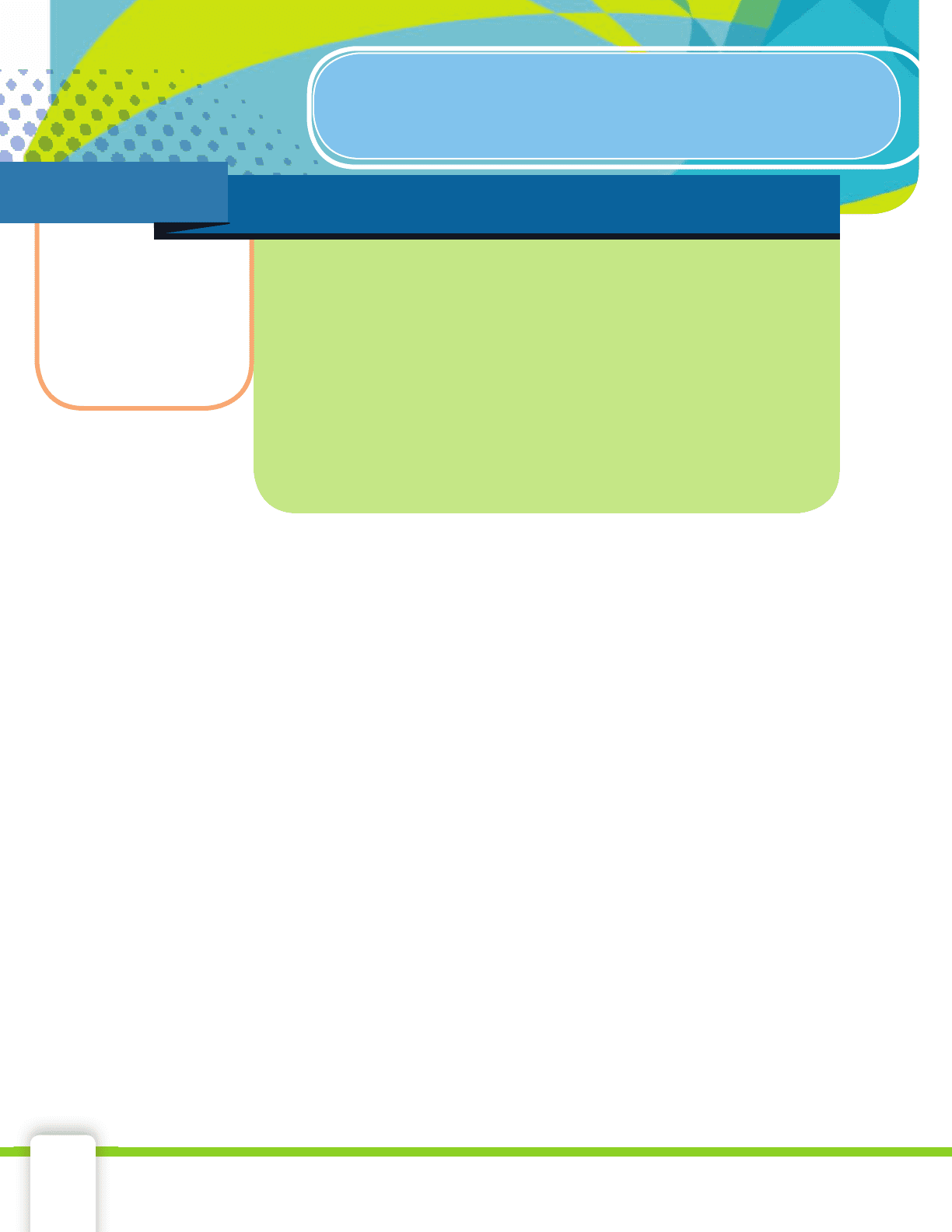
116 Chapter 3 Banking Services
How do people gain access to
money they keep in the bank?
Consumers can have savings, checking, and loan accounts in a variety
of different banks. A survey reported that most consumers consider their
primary bank to be the one where they have their main checking account
even when they use banking services at other banks. A
checking account
is an account at a bank that allows a customer to deposit money, make
withdrawals, and make transfers from the funds on deposit.
A
check is a written order used to tell a bank to pay money (trans-
fer funds) from an account to the check holder. Payments can be made
by writing a paper check or by making an electronic funds transfer. An
electronic funds transfer (EFT) is the process of moving funds elec-
tronically from an account in one bank to an account in another bank.
An EFT is often referred to as an electronic check or e-check. Because the
transfer is electronic, the processing time is very short. Both the paper
and electronic forms of a check are written to a
payee, the receiver of
the transferred funds. The account owner of the check is the
drawer.
Both the payee and the drawer can be a person, persons, or a company.
The checking account needs to have enough money in it to cover the
amount of a check in order for the check to clear, that is, to be paid by
the bank. This process is known as
check clearing.
You can make deposits using a
deposit slip. Often direct deposit
is used to deposit payroll or government checks directly into an account.
The validity and fi nancial worthiness of deposits must be verifi ed before
the bank will allow customers to draw on the funds. If you would like
to receive cash back when you deposit a check, there must be suffi cient
funds already in the checking account. A
hold is put on the checking
direct deposit•
hold•
endorse•
canceled•
insuffi cient •
funds
overdraft •
protection
automated teller •
machine (ATM)
personal •
identifi cation
number (PIN)
maintenance fee•
interest•
single account•
joint account•
check register•
debit•
credit•
Key Terms
checking •
account
check•
electronic •
funds transfer
(EFT)
payee•
drawer•
check clearing•
deposit slip•
Objectives
Understand how •
checking accounts
work.
Complete a check
•
register.
Checking Accounts
3-1
There have been three great inventions since the beginning of
time: fi re, the wheel, and central banking.
Will Rogers, Actor and Columnist
49657_03_ch03_p114-171.indd 11649657_03_ch03_p114-171.indd 116 12/23/09 6:25:37 PM12/23/09 6:25:37 PM

3-1 Checking Accounts 117
account in the amount of the cash received. When the deposit is cleared,
the hold is lifted and all of the money in the account is available.
When cashing a check, the payee must
endorse the check either in
writing, by stamp, or electronically. Once the money is paid to the payee,
the check is
canceled.
If a check is written for an amount that cannot be paid out of the
account, the check is returned, or dishonored. This means that there are
insuffi cient funds in the account and the payee will not receive the
money. Banks charge a fee for processing returned checks. Some banks
offer customers
overdraft protection plans that pay a check even
though there are not enough funds in the account. There is a fee for this
service and the money must be repaid.
Most banks offer
automated teller machines (ATMs) that give
customers 24-hour access to banking services such as deposits and with-
drawals. You need a bank card and a
personal identifi cation number
(PIN)
to use an ATM. Usually there is no charge if you use one of your
bank’s ATMs. If you use another ATM, there may be a fee by the bank
that owns the ATM and your bank as well.
There are many types of checking accounts, the names of which vary
from bank to bank. Each has a different name and different benefi ts and
requirements. Some banks offer free checking while others have accounts
that have a monthly
maintenance fee. Some banks pay interest on
their checking accounts, which is a percentage of the money that is in
the account over a given period of time. Some popular checking accounts
are listed and explained below.
Basic checking accounts
• are the most widely used types of
checking accounts. Customers can move money in and out of the
account by making deposits and writing checks to pay bills or access
money. Many of these accounts do not pay interest.
Interest-bearing checking accounts
• pay customers interest,
usually on a monthly basis, on the money that is in the account.
A minimum balance is often required and a fee is charged if the
account balance drops below that minimum.
Free checking accounts
• require no minimum balance and
charge no maintenance fees. The Federal Truth in Savings Act guar-
antees such accounts are available.
Joint checking accounts
• are accounts owned by more than one
person. All owners have equal access to the money in the account.
Express checking accounts
• are accounts for people who want
to avoid going to a traditional bank. Express accounts are often
accessed electronically via telephone, computer, or ATM. Some
banks charge a fee when an Express account owner uses the services
of bank personnel.
NOW accounts
• stand for negotiable order of withdrawal. These are
free checking accounts that have interest payments attached to them.
Lifeline checking accounts
• are available in many states for low-
income consumers. Fees and minimum balances are low or non-
existent. Lifeline accounts are required by law in many states.
Bank accounts can be owned by an individual or a group of indi-
viduals or a business. In a
single account, only one person can make
withdrawals. These are also called individual or sole owner accounts.
Joint accounts have more than one person listed as the owner. Any
person listed on a joint account can make withdrawals.
49657_03_ch03_p114-171.indd 11749657_03_ch03_p114-171.indd 117 12/23/09 6:25:40 PM12/23/09 6:25:40 PM
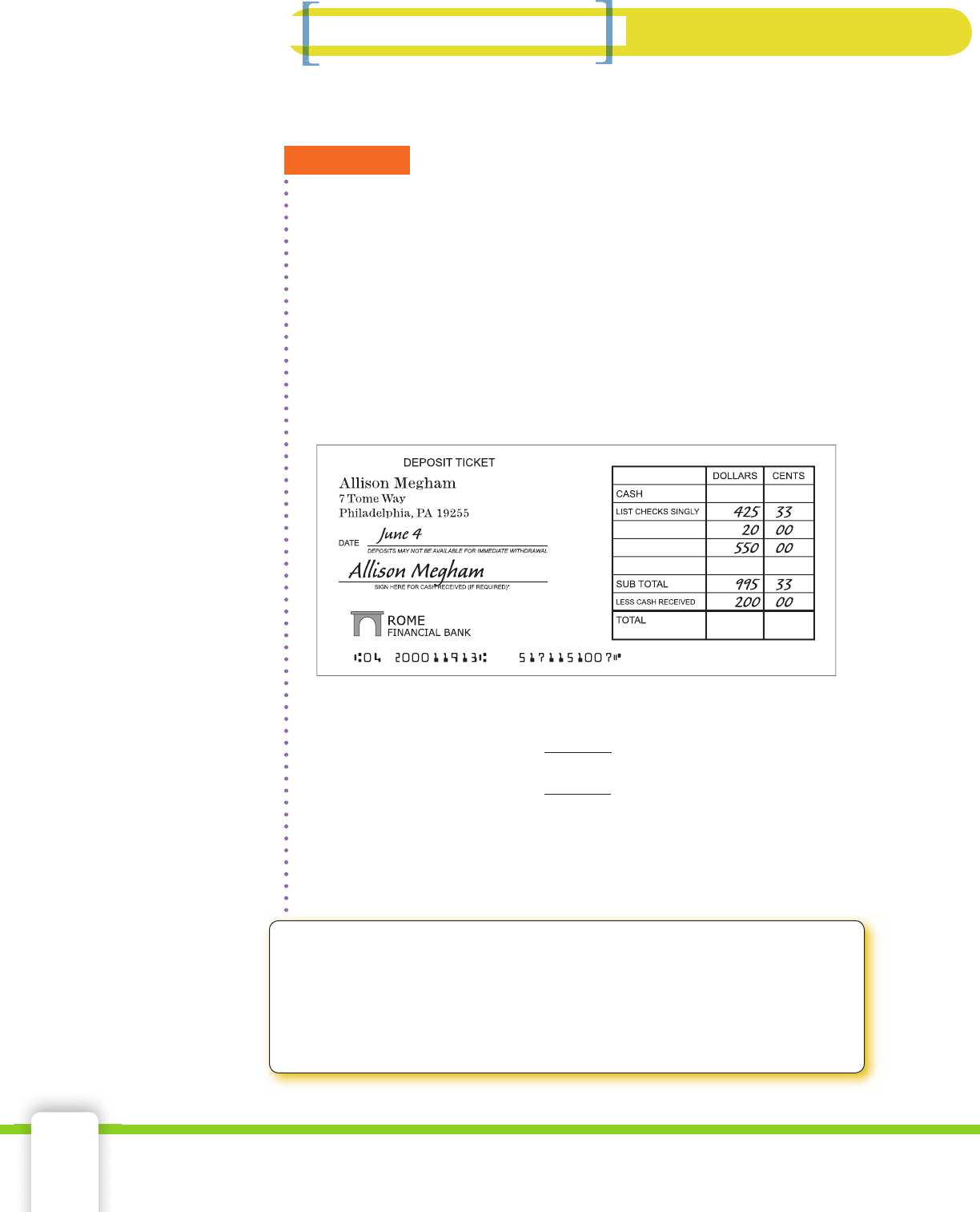
118 Chapter 3 Banking Services
Here you will learn how to deposit money into a checking account and
to track the transactions in the account on a monthly basis.
EXAMPLE 1
Allison currently has a balance of $2,300 in her checking account. She
deposits a $425.33 paycheck, a $20 rebate check, and a personal check
for $550 into her checking account. She wants to receive $200 in cash.
How much will she have in her account after the transaction?
SOLUTION Allison must fi ll out a deposit slip and hand it to the bank
teller along with her endorsed checks. Although deposit slips vary
from bank to bank, there is usually a line for cash deposits and a few
lines for individual check deposits and for cash received. Allison is
not making a cash deposit, so the cash line is blank. She lists the three
checks on the deposit slip separately. In order for Allison to get $200
back from this transaction, she must have at least that amount already
in her account.
Add the check amounts. $425.33
20.00
+550.00
$995.33
Subtract the cash received. –200.00
Total on deposit slip $795.33
Allison’s current balance is $2,300.
Add current balance and deposit amount. 2,300 + 795.33 = 3,095.33
Allison’s new balance is $3,095.33.
CHECK
■
YOUR UNDERSTANDING
Lizzy has a total of x dollars in her checking account. She makes a
deposit of b dollar in cash and two checks each worth c dollars. She
would like d dollars in cash from this transaction. She has enough
to cover the cash received in her account. Express her new checking
account balance after the transaction as an algebraic expression.
Skills and Strategies
49657_03_ch03_p114-171.indd 11849657_03_ch03_p114-171.indd 118 12/23/09 6:25:40 PM12/23/09 6:25:40 PM
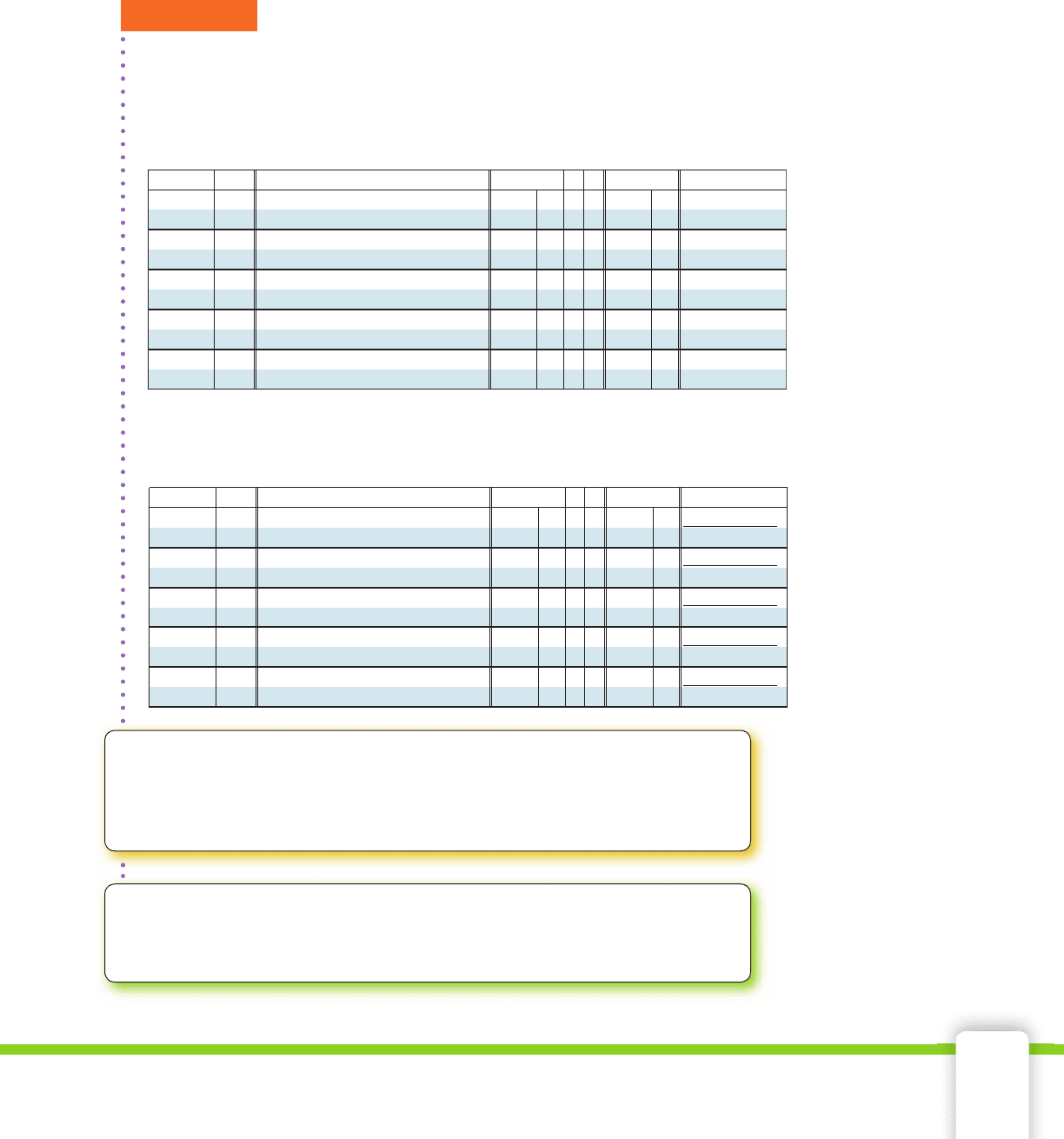
3-1 Checking Accounts 119
Check Registers
You should keep a record of all transactions in your checking account,
including checks written, deposits made, fees paid, ATM withdrawals,
and so on. This record is a
check register. The record can be handwrit-
ten or electronic. It tracks the
debits (withdrawals) and credits (deposits)
of a checking account.
EXAMPLE 2
Nick has a checking account with the Park Slope Savings Bank. He writes
both paper and electronic checks. For each transaction, Nick enters the
necessary information: check number, date, type of transaction, and
amount. He uses E to indicate an electronic transaction. Determine the
balance in his account after the Star Cable Co. check is written.
SOLUTION Perform the calculations needed as shown below. The
balance in Nick’s register is $2,499.90.
CODE
3271
NUMBER OR
DATE TRANSACTION DESCRIPTION
AMOUNT
PAYMENT
AMOUNT
DEPOSIT
$
$
BALANCE
3272
E
E
5/5
5/7
5/9
5/10
5/10
Dewitt Auto Body (Car Repair)
Kate’s Guitar Hut (Strings)
Deposit (Paycheck)
Verizon Wireless
Star Cable Co.
1,721 00
32 50
101 50
138 90
FEE
821 53
3,672.27
CODE
3271
NUMBER OR
DATE TRANSACTION DESCRIPTION
AMOUNT
PAYMENT
AMOUNT
DEPOSIT
$
$
BALANCE
3272
E
E
5/5
5/7
5/9
5/10
5/10
Dewitt Auto Body (Car Repair)
Kate’s Guitar Hut (Strings)
Deposit (Paycheck)
Verizon Wireless
Star Cable Co.
1,721 00
32 50
101 50
138 90
FEE
821 53
3,672.27
- 1,721.00
1,951.27
- 32.50
1,918.77
+ 821.53
2,740.30
- 101.50
2,638.80
- 138.90
2,499.90
EXTEND
■
YOUR UNDERSTANDING
Would the fi nal balance change if Nick had paid the cable bill
before the wireless bill? Explain.
CHECK
■
YOUR UNDERSTANDING
Nick writes a check to his friend James Sloan on May 11 for $150.32.
What should he write in the check register and what should the new
balance be?
49657_03_ch03_p114-171.indd 11949657_03_ch03_p114-171.indd 119 12/23/09 6:25:41 PM12/23/09 6:25:41 PM

1. How might the quote apply to what has been outlined in this lesson?
2. Jackie deposited a $865.98 paycheck, a $623 stock dividend check,
a $60 rebate check, and $130 cash into her checking account. Her
original account balance was $278.91. Assuming the checks clear,
how much was in her account after the deposit was made?
3. Rich has t dollars in his checking account. On June 3, he deposited
w, h, and v dollars, and cashed a check for k dollars. Write an alge-
braic expression that represents the amount of money in his account
after the transactions.
4. John cashed a check for $630. The teller gave him three fi fty-dollar
bills, eighteen twenty-dollar bills, and t ten-dollar bills. Determine
the value of t.
5. Gary and Ann have a joint checking account. Their balance at the
beginning of October was $9,145.87. During the month they made
deposits totaling $2,783.71, wrote checks totaling $4,871.90, paid
a maintenance fee of $12, and earned $11.15 in interest on the
account. What was the balance at the end of the month?
6. Anna has a checking account at Garden City Bank. Her balance at
the beginning of February was $5,195.65. During the month, she
made deposits totaling $6,873.22, wrote checks totaling c dollars, was
charged a maintenance fee of $15, and earned $6.05 in interest. Her
balance at the end of the month was $4,200.00. What is the value of c?
7. Queens Meadow Bank charges a monthly maintenance fee of $13
and a check writing fee of $0.07 per check. Last year, Mark wrote 289
checks from his account at Queens Meadow. What was the total of all
fees he paid on that account last year?
8. Joby had $421.56 in her checking account when she deposited g
twenty-dollar bills and k quarters. Write an expression that repre-
sents the amount of money in her account after the deposit.
9. Neka cashed a check for $245. The teller gave him two fi fty-dollar
bills, six twenty-dollar bills and f fi ve-dollar bills. Determine the
value of f.
10. Olivia cashed a check for $113. The teller gave her four twenty-dollar
bills, x ten-dollar bills, and three one-dollar bills. Find the value of x.
11. Hector had y dollars in his savings account. He made a deposit of
twenty-dollar bills and dollar coins. He had four times as many dollar
coins as he had twenty-dollar bills and the total of his twenty-dollar
bills was $60. Write an expression for the balance in Hector’s account
after the deposit.
There have been three great inventions since the beginning of
time: fi re, the wheel, and central banking.
Will Rogers, Actor and Columnist
Applications
120 Chapter 3 Banking Services
49657_03_ch03_p114-171.indd 12049657_03_ch03_p114-171.indd 120 12/23/09 6:25:41 PM12/23/09 6:25:41 PM

3-1 Checking Accounts 121
12. On September 1, Chris Eugene made the following band equipment
purchases at Leslie’s Music Store. Calculate her total bill. Complete a
check for the correct amount. Print a copy of the check from www.
cengage.com/school/math/fi nancialalgebra.
13. Create a check register for the transactions listed. There is a $2.25 fee
for each ATM use.
a. Your balance on 10/29 is $237.47
b. You write check 115 on 10/29 for $18.00 to Fox High School.
c. You deposit a paycheck for $162.75 on 10/30.
d. You deposit a $25 check for your birthday on 11/4.
e. On 11/5, you go to a sporting event and run out of money. You
use the ATM in the lobby to get $15 for snacks.
f. Your credit card bill is due on 11/10, so on 11/7 you write check
116 to Credit USA for $51.16.
g. Your sister repays you $20 on 11/10. You deposit it.
h. You withdraw $25 from the ATM to buy fl owers on 11/12.
i. You deposit your paycheck for $165.65 on 11/16.
j. Your deposit a late birthday check for $35 on 11/17.
14. Ridgewood Savings Bank charges a $27 per check overdraft protec-
tion fee. On July 8, Nancy had $1,400 in her account. Over the next
four days, the following checks arrived for payment at her bank:
July 9, $1,380.15; July 10, $670 and $95.67; July 11, $130; and
July 12, $87.60. How much will she pay in overdraft protection fees?
How much will she owe the bank after July 12?
15. 123 Savings and Loan charges a monthly fee of $8 on checking
accounts and an overdraft protection fee of $33. Neela’s check reg-
ister showed she had a balance of $456 when she wrote a check for
$312. Three days later she realized her check register had an error
and she actually only had $256. So she transferred $250 into her
checking account. The next day, her monthly account statement was
sent to her. What was the balance on her statement?
LIST PRICEDESCRIPTION TOTAL
NUMBER
CATALOG
Speaker Cabinets
Speaker Cabinets
Horns
Audio Console
Power Amplifier
Microphones
Microphone Stands
RS101
RG306
BG42
LS101
NG107
RKG-1972
1957-210
$400.00
$611.00
$190.00
$1,079.00
$416.00
$141.92
$32.50
QUANTITY
2
2
2
1
5
8
8
TOTAL
13% DISCOUNT
8% SALES TAX
TOTAL COST
SALE PRICE
49657_03_ch03_p114-171.indd 12149657_03_ch03_p114-171.indd 121 12/23/09 6:25:42 PM12/23/09 6:25:42 PM

122 Chapter 3 Banking Services
16. Create a check register for the transactions listed. Download a blank
check register from www.cengage.com/school/math/fi nancialalgebra.
a. Your balance on 12/15 is $2,546.50.
b. On 12/16, you write check 2345 for $54 to Kings Park High
School Student Activities.
c. On 12/17, you deposit your paycheck in the amount of $324.20.
d. Your grandparents send you a holiday check for $100 which you
deposit into your account on 12/20.
e. On 12/22 you write three checks: 2346 to Best Buy in the amount
of $326.89, 2347 to Macy’s in the amount of $231.88, and 2348
to Target in the amount of $123.51.
f. On 12/24, you go to the Apple Store. As you are writing the
check for $301.67, you make a mistake and must void that check.
You pay with the next available check in your checkbook.
g. On 12/26, you return a holiday gift. The store gives you $98. You
deposit that into your checking account.
h. On 12/28, you write an e-check to Allstate Insurance Company
in the amount of $876.00 to pay your car insurance.
i. On 12/29, you withdraw $200 from an ATM. There is a $1.50
charge for using the ATM.
17. Download a copy of the check register shown below from
www.cengage.com/school/math/fi nancialalgebra. Complete items a
through y.
CODE
621
ITEM NO. FOR
DATE DESCRIPTION OF TRANSACTION
10/3
OTHER
TO
FOR
Telephone Co.
Dec. Bill
SUBTRACTIONS
TRANSACTION
WITHDRAWAL
AMOUNT OF
PAYMENT OR
ADDITIONS
INTEREST
AMOUNT OF
DEPOSIT OR
PLEASE BE SURE TO DEDUCT
CHANGES THAT AFFECT YOUR ACCOUNT
BALANCE FORWARD
– 71 10
1,792 80
1,863 90
622
10/7
500 00
TO
FOR
Banner Reality
Rent
10/8
51 12
TO
FOR
Electric Co.
Dec. Bill
624
10/10
25 00
TO
FOR
Cathy Santoro
Piano Lesson
10/15
TO
FOR
Deposit
650 00
625 10/16
200 00
TO
FOR
Don’s Day Camp
Kid’s Summer Camp
626 10/18
90 00
TO
FOR
Ed’s Sporting Goods
Winter Coat
627 10/21
49 00
TO
FOR
Maple Place Garage
antifreeze & hose
628 10/22
65 00
TO
FOR
Dr. Moe Goldstein
Check-up
11/4
300 00
TO
FOR
Hicksville H.M.O.
yearly premium
11/5
TO
FOR
Deposit
400 00
11/9
371 66
TO
FOR
State Insurance Co.
Auto Insurance
– 371 66
f.
h.
j.
l.
n.
q.
s.
u.
w.
y.
z.
e.
g.
i.
k.
m.
p.
r.
t.
v.
x.
a.
b.
c.
d.
49657_03_ch03_p114-171.indd 12249657_03_ch03_p114-171.indd 122 12/23/09 6:25:43 PM12/23/09 6:25:43 PM
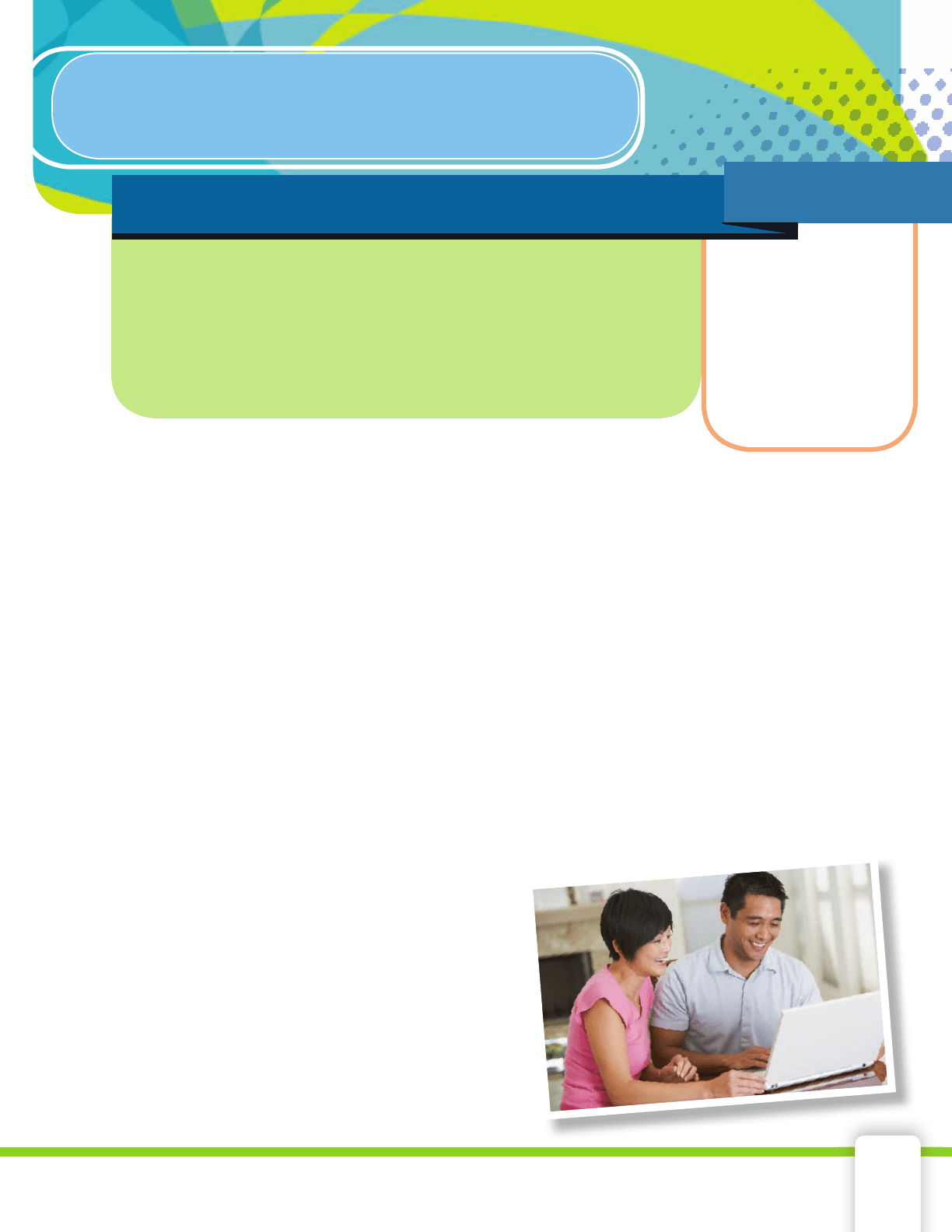
3-2 Reconcile a Bank Statement 123
How do checking account users make
sure that their records are correct?
A customer keeps a record of all transactions concerning a checking
account in a paper or electronic check register. The bank also keeps a
record of all transactions. Every month, the bank makes available a state-
ment listing all of the transactions and balances for the account. The
bank statement contains important information related to the account.
The
• account number appears on all checks, deposit slips, and
paper and electronic bank statements.
The
• bank statement includes all transactions that have occurred
for a period of approximately one month. The
statement period
indicates the dates in which the transactions occurred.
The
• starting balance is the amount of money in a checking
account at the beginning of a statement period.
The
• ending balance is the amount of money in a checking
account at the end of a statement period.
The deposits section shows the money that was put into the account
•
during the statement period. Deposits that do not appear on
the statement are
outstanding deposits.
Checks that do not appear on the statement
•
are outstanding checks.
Whether using paper or electronic statements,
you should verify the bank’s records to make sure
no mistakes have been made. This process
is called
balancing a checkbook or reconciling
a bank statement. Most bank statements include
a checking account summary which guides the
user through the reconciling process. Check regis-
ters contain a column to place a check mark
for cleared items to assist in balancing.
outstanding •
deposits
outstanding checks•
balancing•
reconciling•
Key Terms
account number•
bank statement•
statement period•
starting balance•
ending balance•
Objectives
Reconcile •
a checking
account with a
bank statement
by hand and
by using a
spreadsheet.
Reconcile a Bank Statement
3-2
My problem lies in reconciling my gross habits with my net
income.
Errol Flynn, Actor
t
appear
on
© MONKEY BUSINESS IMAGES, 2009/USED UNDER
LICENSE FROM SHUTTERSTOCK.COM
49657_03_ch03_p114-171.indd 12349657_03_ch03_p114-171.indd 123 12/23/09 6:25:43 PM12/23/09 6:25:43 PM
